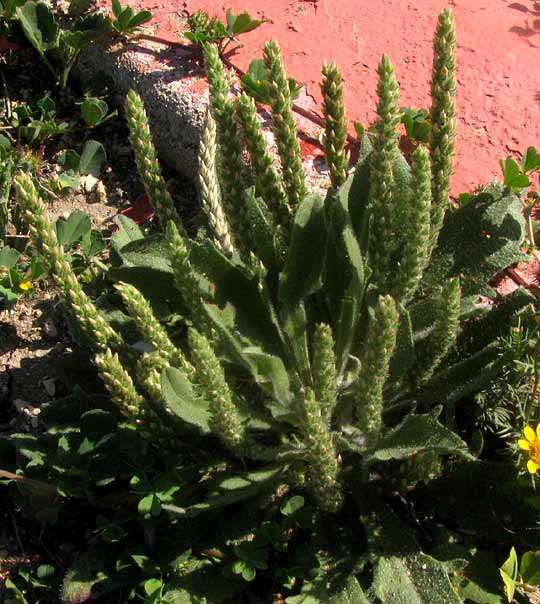Excerpts from Jim Conrad's
Naturalist Newsletter
from the April 13, 2014 Newsletter issued from the Frio Canyon Nature Education Center in the valley of the Dry Frio River in northern Uvalde County, southwestern Texas, on the southern border of the Edwards Plateau; elevation ~1750m (~5750 ft); N29.62°, W99.86°; USA
REDSEED PLANTAIN
In the tropics a plantain is like a big banana, but in North America the word plantain refers to a certain kind of humble weed typically growing along sidewalks and in abandoned lots. Our North American plantains belong to the genus Plantago. The other day a plantain at the edge of a parking lot in Uvalde caught my attention. That's it below:

Typical of the genus Plantago, this plant produces greenish, cylindrical spikes of obscure flowers. The flowers' calyxes are greenish and fairly typical looking, but plantain corollas tend to be somewhat papery and maybe stiff, and this species' remain stiffly erect, not opening like the corollas of most plants. You can see some of this plantain's flowers close-upbelow:

It wasn't the flowers that caught my attention, though, but rather the leaves, shown below:

Though having the major veins arising at the blade base and continuing more or less parallel with one another through the rest of the blade is typical, and I've known several hairy species, I'm not accustomed to seeing plantain leaves with "teeth" or small, narrow lobes along their margins, as these blades have.
This is the Redseed Plantain, also called Redseed Indianwheat, PLANTAGO RHODOSPERMA. Unlike some of our most common weedy plantains, who are invasive from Eurasia, this species is native American, occurring mostly in the south-central states from southern Nebraska south through our area, New Mexico and Arizona into the northern half of Mexico.
I've read that chewing the leaves into a pulp, you can make a poultice that helps if you apply it to a fire ant bite or cut.